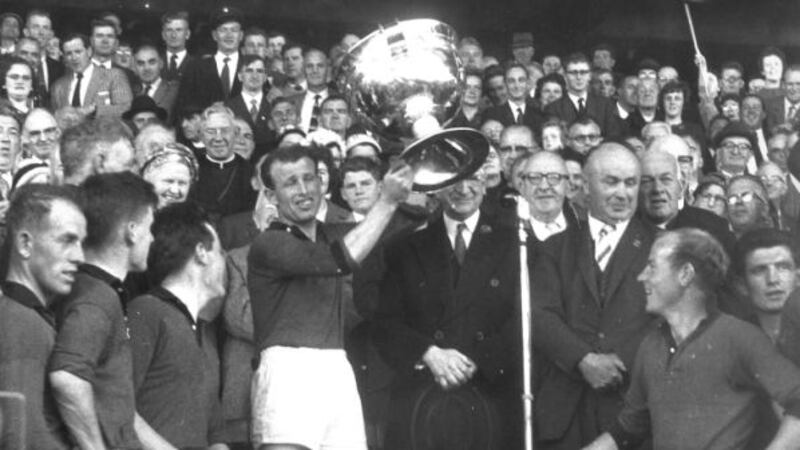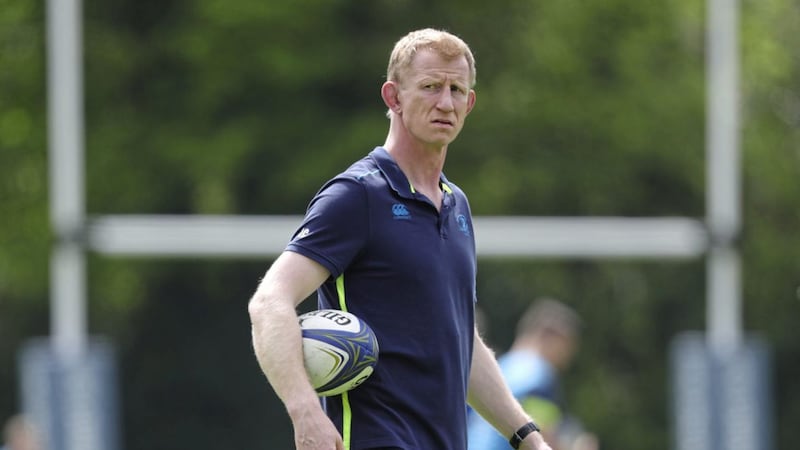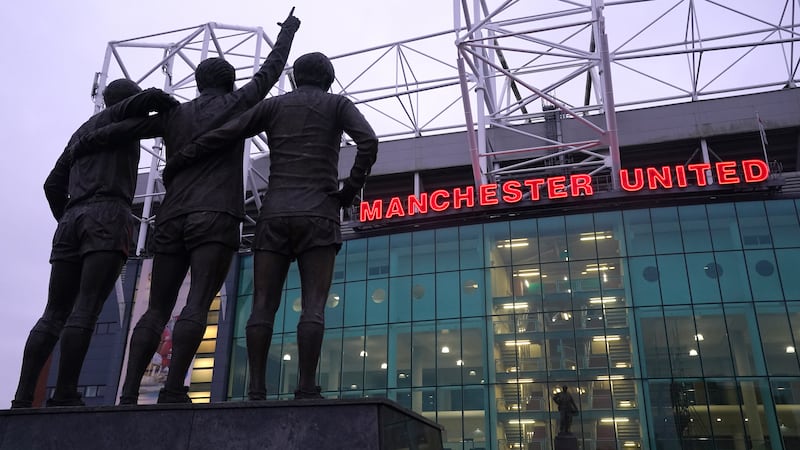SINCE the late 1950s, Gaelic football in Ulster has produced four supreme scoring forwards, who are also among the greatest such players in the history of the game.
The term 'scoring forward' refers to a distinguishing mark that, through converting frees and scoring from play in game after game, year after year, they are the major and critical contributors to a team's success. But in order to join the ranks as a great scoring forward, of a position of supreme achievement in the game, three criteria must be fulfilled as follows, with the third in two parts:
1. He must be consistently outstanding over a long span of 10 to 12 years, confirmed by scoring records and personal awards
2. This consistency must occur at the highest level of the game, at All-Ireland senior county or club level
3. He must be fearless in temperament and deliver the big scores on the big occasion
Four Ulster players fulfil this criteria with the highest distinction, and each is distinctive in their specific artistry: Paddy Doherty, Seán O'Neill, Peter Canavan and Oisín Mc Conville. They are among the greatest in the history of the game.
Players such as Cyril Dunne, Jimmy Keaveney, Michael Sheehy and Colm Cooper are also of this rank in terms of longevity of brilliance at the highest level. It is true that every All-Ireland winning county has a natural scoring forward/free-taker, but the duration of their team's success at the highest level is taken into account.
One other factor has to be taken into consideration, that all four blossomed as they did and came to national prominence as they did because their counties or clubs were specifically organised to a high level during their careers.
PADDY DOHERTY
Ballykinlar-born Paddy Doherty showed precocious form as a natural scoring forward from an early age with his local club and with Down minors in the early 1950s.
Born in 1934, his folklore status was on the rise even before Down's great days, such as scoring 16 points in a club match (10 from play) and, in his brief diversion into soccer, finding the net 32 times in half a season with Ballyclare Comrades, after an equally brief and unsettled period with Lincoln City.
Doherty made his debut for Down seniors in 1954 and, when the county began to seriously reorganise the senior team in 1957, the critical requirement for a natural scoring forward pointed immediately to Ballykinlar, and so the key-stone was ready for the building of the bridge.
Soccer was not his natural habitat. Gaelic football gave a much wider scope for his creative powers and, for 14 years at national level, his scoring feats brought standards to fresh heights. But there was more to him than a mere scoring machine. Of all the free-takers over the last half-century and possibly beyond, his art represented the most flawless, joyous expressions of one of Gaelic football's most intimate skills.
No scoring forward conveyed such a sense of exhilaration in their own brilliance, so endeared the people to his ways, seeming to move from time to time on the rims of the impossible. The memories of those who saw him on the field of play do not lose their freshness after more than 40 years - of scoring points from over the right shoulder with his back to the goal, of the ball suddenly rising like a lark out of a ruck of players to soar over the bar, or the stooped run back down the field after the kill.
Game after game, year after year, Paddy Doherty's scoring fluency never deserted him and he was guaranteed an average five or six points a game - in the All-Ireland final of 1960, he scored 1- 5 out of Down's victorious total of 2-10.
Doherty was also a master of the long pass. Three consecutive 40 to 50-yard long passes of utter precision led directly to Down's three first half goals against a ruthless Offaly defence in the 1961 final when six points behind.
The first fell into the out-coming path of James McCartan as Tony Hadden drew a defender and McCartan caught, turned and slammed to the net. The second was raced onto and converted by Seán O'Neill, and the third floated to PJ McElroy, who palmed the ball into the path of Breen Morgan. These goals involved all six forwards, 10 minutes of brilliance probably never seen before in the game, and never seen again.
But it was in a Railway Cup game between Ulster and Connacht in 1965 - when the competition attracted 40,000-plus spectators – that the ultimate exhibition of free-taking occurred, involving the masters from those two provinces, Doherty himself and Cyril Dunne of Galway. Playing with a heavy 'March' ball and from all angles, Doherty scored 12 points, 10 from frees, and Dunne hit 11 points, eight from frees. There were no misses from either, 100 per cent return, each Summa cum Laude as the masterclass moved from one end of the field to the other throughout the game.
Nor did either employ any of the modern-day geometric calculations and rituals, but simply set the ball down, stepped back, and kicked it over the bar.
Then there was Doherty's conversion of the breakthrough penalty against Offaly in the semi-final of 1960 when Down's cause seemed lost and, of course, the penalty of all penalties that shifted history in the 1960 final against Kerry.
Holder of three All-Ireland Senior Football Championships (1960, '61 and '68), three National Leagues (1960, '62 and '68), seven Ulster Senior Football Championships (1959, '60, '61, '63, '65, '66 and '68), six Railway Cup medals, and three Down Junior Football Championships, he retired from inter-county football in 1971.
The legacy of the great Ballykinlar man cannot be placed in any conventional manner, and it can only be said that whatever gods or ancients decreed that the highest arts of Gaelic football should touch the mystical, he was their favourite son.
SEÁN O'NEILL
The difference between Paddy Doherty and Seán O'Neill is the difference between Mozart and Beethoven. The former represented the perfection of the existing classical order, the latter created a new order and perfected what he had created.
No less deadly a finisher than his fellow Down man - as his 85 goals and 500 points in senior county football testify - Newry-born O'Neill pioneered new vistas of attacking play, notably the role of the full-forward as the creative attacking dynamic of the team. This initiative would greatly influence the future structure of attacking football and was notably taken up by Dublin and Kerry in the 1970s as the keystone to their success, where the traditional centre half-forward was given a roaming role, with direct access opened to the full-forward as the critical strategy.
As well as one of its greatest players, Seán O'Neill was a genuine philosopher of the game. The potential of Gaelic football as a creative dynamic quite obsessed him, and how it accommodates the specific Irish psyche in this regard. He looked on the game as an expression of life itself, full of possibilities and challenges. He felt that few events so challenge an individual more than their isolation on the field of play in the big hour, when inner doubts come out of hiding and must be confronted, and that such a challenge faced and overcome is one of most maturing and uplifting of experiences.
As a player, O'Neill possessed an astonishing speed of mind in identifying the potential of a given situation on the field of play, creating openings out of next to nothing, destabilising defences in a sudden check-mate move and, above all, utilising a scoring faculty of great power and accuracy from either foot.
He scavenged for the half and quarter-chance, taught that a player must always follow up and be ready to pounce on mistakes and mishaps. This was most dramatically realised in the opening minutes of the All-Ireland final of 1968 against Kerry when a high shot from Peter Rooney came back off the post and dropped to the ground, where the incoming O'Neill had bounded onto the scene from nowhere, and the ball was in the net.
Like the other scoring masters, he was a man for the big score on the big occasion, and there were many of these in his career, such as against Kerry in the 1961 All-Ireland semi-final when the Munster champions set out to show that their All-Ireland defeat the previous year was a one–off. In the opening minutes, he engineered an opening but instead of going for a safe point drove the ball to the net. An unsettled Kerry never recovered and lost by six points. Then there was the left-footed rasper in the final that drew Down level and took them out of adversity against Offaly in 1961.
But these were probably surpassed by the critical goal in the All-Ireland semi-final of 1968 against Galway when the game see-sawed in the second half with both sides desperate for the critical score. It came when Rooney gathered possession 40 yards out and saw O'Neill moving across the field further in to take the pass. It was delivered immediately and, from 30 yards out, he left-footed a powerful shot past the Galway 'keeper.
A few minutes after that - almost as an encore - he fired over a huge point with the other foot that killed off all Galway resistance and sent Down fans jubilant. This kind of scoring and creative play went on and on throughout his career at club, county, provincial and university level.
Yet perhaps the most dramatic and challenging moment in his county career came at the very end of the National League final against Dublin in 1962 before a record League crowd at Croke Park when Down trailed by 1-7 to 2-5 and were award a last-minute penalty. Paddy Doherty, the usual penalty-taker, felt he had not sufficiently recovered from a heavy tackle minutes before, and so the 22-year-old Seán O'Neill stepped up to look down the barrel of a gun.
Then the silence entered the scene, the draining silence that wilted many a World Cup player in the penalty shoot-out, isolated them beyond composure, breached their inner core. All around O'Neill, a cliff of heads settled, friend and opponent, utterly, solemnly quiet and out of this abyss he moved up to the ball and drove it into the back of the net.
On his retirement, he managed the Down minors to an All-Ireland success in 1977 and, in 1982, took Queen's to a Sigerson Cup victory. His passion for the game remains undiminished, ever listening and offering wisdom, ever giving encouragement to players and those in management, always enthusiastic and positive, ever faithful to his mission.
Holder of three All-Ireland Senior medals, three NFL Medals, eight Ulster Senior Championship medals, eight Railway Cup medals, four Down Senior medals with Newry Mitchel's, two Allstars and a Sigerson medal with QUB.
He was voted Ulster Player of the Century and selected on the GAA Team of the Century in the centenary year of 1984.
On Wednesday, Peter Makem assesses the talents of Tyrone's Peter Canavan and Armagh's Oisín McConville...








